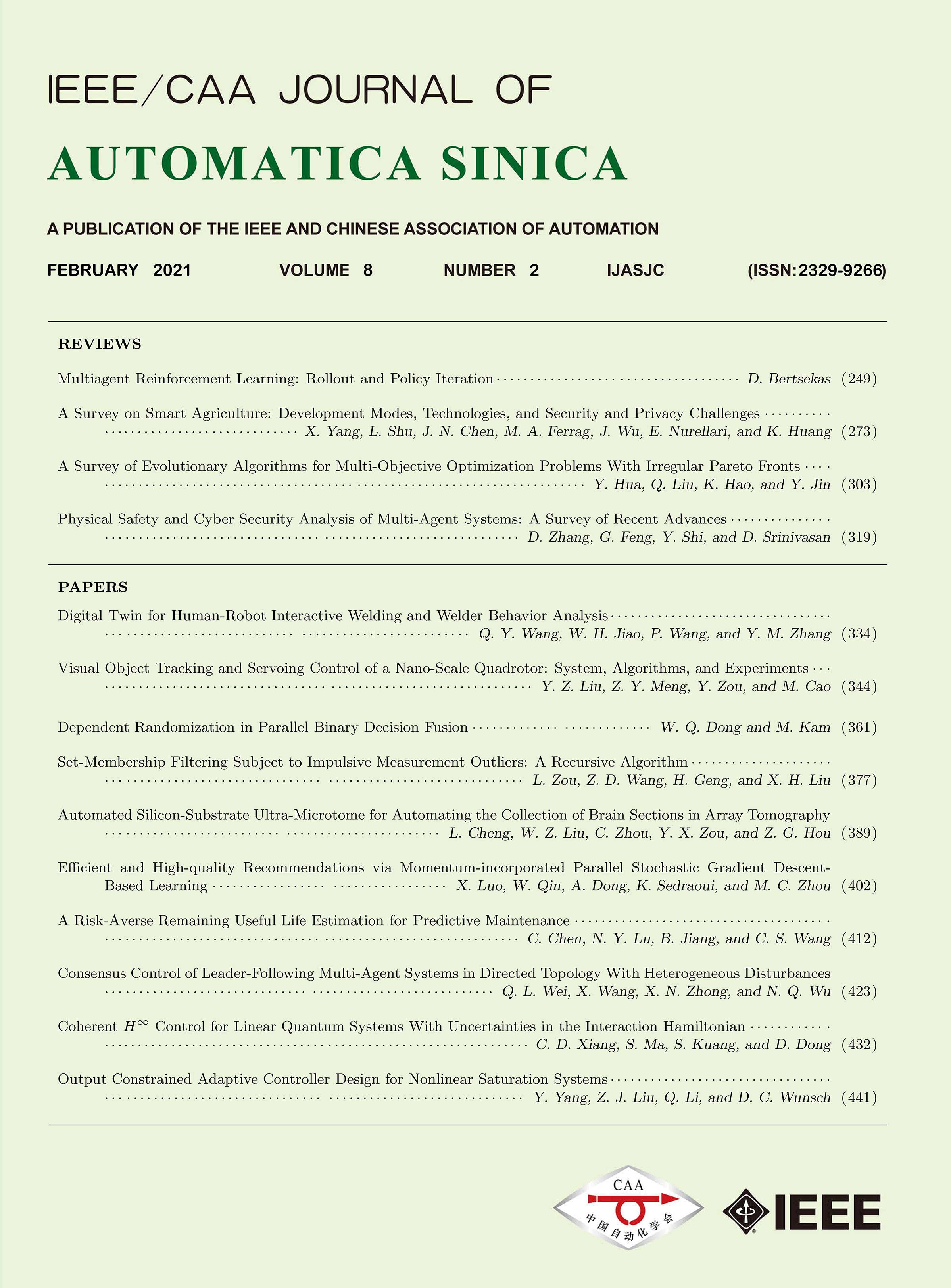 Volume 8
Issue 2
Volume 8
Issue 2
IEEE/CAA Journal of Automatica Sinica
| Citation: | Weiqiang Dong and Moshe Kam, "Dependent Randomization in Parallel Binary Decision Fusion," IEEE/CAA J. Autom. Sinica, vol. 8, no. 2, pp. 361-376, Feb. 2021. doi: 10.1109/JAS.2021.1003823 |

| [1] |
I. Y. Hoballah and P. K. Varshney, “Neyman-Pearson detection with distributed sensors,” in Proc. 25th IEEE Conf. Decision and Control, vol. 25, pp. 237–241, 1986.
|
| [2] |
S. Thomopoulos, R. Viswanathan, and D. Bougoulias, “Optimal distributed decision fusion,” IEEE Trans. Aerospace and Alectronic Aystems, vol. 25, no. 5, pp. 761–765, 1989.
|
| [3] |
M. Kam, W. Chang, and Q. Zhu, “Hardware complexity of binary distributed detection systems with isolated local Bayesian detectors,” IEEE Trans. Systems,Man and Cybernetics, vol. 21, no. 3, pp. 565–571, 1991. doi: 10.1109/21.97477
|
| [4] |
P. Willett and D. Warren, “The suboptimality of randomized tests in distributed and quantized detection systems,” IEEE Trans. Information Theory, vol. 38, no. 2, pp. 355–361, 1992. doi: 10.1109/18.119692
|
| [5] |
J. N. Tsitsiklis, “Decentralized detection,” Advances in Statistical Signal Processing, vol. 2, no. 2, pp. 297–344, 1993.
|
| [6] |
J. D. Papastavrou and M. Athans, “The team ROC curve in a binary hypothesis testing environment,” IEEE Trans. Aerospace and Electronic Systems, vol. 31, no. 1, pp. 96–105, 1995. doi: 10.1109/7.366296
|
| [7] |
Y. I. Han, “Randomized fusion rules can be optimal in distributed Neyman-Pearson detectors,” IEEE Trans. Information Theory, vol. 43, no. 4, pp. 1281–1288, 1997. doi: 10.1109/18.605596
|
| [8] |
S. Acharya, J. Wang, and M. Kam, “Distributed decision fusion using the Neyman-Pearson criterion,” in Proc. 17th IEEE Int. Conf. Information Fusion, pp. 1–7, 2014.
|
| [9] |
W. Dong and M. Kam, “Parallel decentralized detection with dependent randomization,” in Proc. 52nd IEEE Annu. Conf. Information Sciences and Systems, pp. 1–6, 2018.
|
| [10] |
P. K. Varshney, E. Masazade, P. Ray, and R. Niu, “Distributed detection in wireless sensor networks,” in Distributed Data Fusion for Network-Centric Operations, D. Hall, C.-Y. Chong, J. Llinas, and M. Liggins II, Eds., ch. 4, CRC Press, 2013.
|
| [11] |
A. T. Zijlstra, Calculating the 8th Dedekind Number. Ph.D. Thesis, University of Groningen, 2013.
|
| [12] |
H. L. Van Trees, Detection, Estimation, and Modulation Theory, Section 2.2.2. Wiley, 1968.
|
| [13] |
Q. Yan and R. S. Blum, “On some unresolved issues in finding optimum distributed detection schemes,” IEEE Trans. Signal Processing, vol. 48, no. 12, pp. 3280–3288, 2000.
|
| [14] |
J. Luo, J. Ni, and Z. Liu, “Distributed decision fusion under nonideal communication channels with adaptive topology,” Information Fusion, vol. 45, pp. 190–201, 2019. doi: 10.1016/j.inffus.2018.02.001
|
| [15] |
M. A. Al-Jarrah, A. Al-Dweik, M. Kalil, and S. S. Ikki, “Decision fusion in distributed cooperative wireless sensor networks,” IEEE Trans. Vehicular Technology, vol. 68, no. 1, pp. 797–811, 2018.
|
| [16] |
Y. He, S. Li, and Y. Zheng, “Distributed state estimation for leak detection in water supply networks,” IEEE/CAA J. Autom. Sinica, pp. 1–9, 2017. DOI: 10.1109/JAS.2017.7510367
|
| [17] |
M. Ghahramani, M. Zhou, and C. T. Hon, “Mobile phone data analysis: A spatial exploration toward hotspot detection,” IEEE Trans. Automation Science and Engineering, vol. 16, no. 1, pp. 351–362, 2018.
|
| [18] |
J. Cheng, M. Chen, M. Zhou, S. Gao, C. Liu, and C. Liu, “Overlapping community change-point detection in an evolving network,” IEEE Trans. Big Data, vol. 6, no. 1, pp. 189–200, 2020. doi: 10.1109/TBDATA.2018.2880780
|